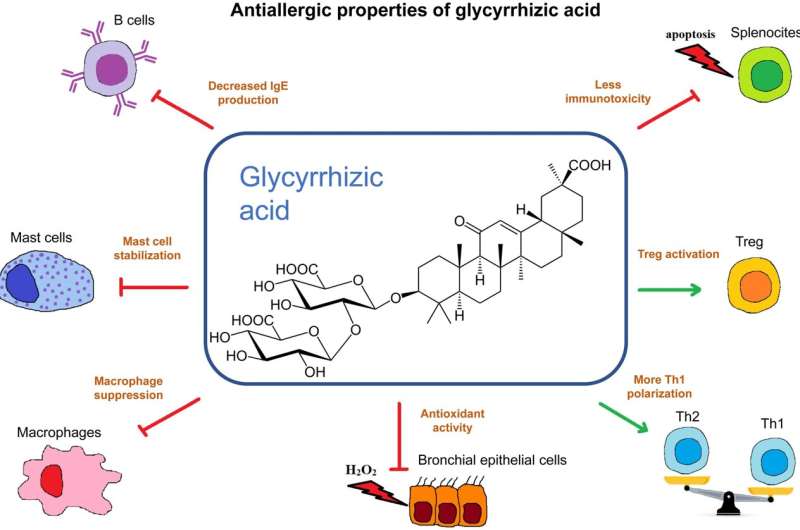This article has been reviewed according to Science X's editorial process and policies. Editors have highlighted the following attributes while ensuring the content's credibility:
fact-checked
proofread
Study reviews delivery systems using glycyrrhizic acid for allergen-specific immunotherapy

The prevalence of allergic diseases has been increasing globally, posing significant public health challenges. Allergic reactions can range from mild, such as allergic rhinitis (AR) and conjunctivitis, to severe, like allergic bronchial asthma (BA). Conventional allergy treatments like antihistamines primarily address symptoms rather than underlying immunological mechanisms.
Allergen-specific immunotherapy (ASIT) offers a pathogenetic treatment approach, potentially preventing the progression of allergies from mild reactions like allergic rhinitis to more serious conditions like bronchial asthma. A paper reviews allergic bronchial asthma and allergic rhinitis, the application of ASIT in treating these conditions, and explores glycyrrhizic acid (GA) as a promising delivery agent for ASIT. The work is published in the journal Exploratory Research and Hypothesis in Medicine.
AR and allergic conjunctivitis are among the most common allergic conditions, significantly affecting patients' quality of life. AR is characterized by symptoms such as nasal congestion, itching, sneezing, and rhinorrhea, while conjunctivitis involves ocular itching, redness, and tearing.
Diagnosis typically involves a detailed patient history, symptom evaluation, and confirmatory tests such as skin prick tests or specific IgE measurements. Treatment options include antihistamines, corticosteroids, and immunomodulatory agents, which can manage symptoms but often require long-term use with potential side effects.
BA, particularly allergic asthma, is a chronic inflammatory disease of the airways triggered by allergens. Symptoms include wheezing, shortness of breath, chest tightness, and coughing, often exacerbated at night or early morning. The pathophysiology of BA involves complex interactions between genetic predisposition and environmental factors.
Diagnosis involves clinical assessment, spirometry, and bronchial provocation tests. Management strategies include inhaled corticosteroids, β-agonists, leukotriene modifiers, and biologics targeting specific inflammatory pathways. However, these treatments do not cure the disease and mainly focus on controlling symptoms and preventing exacerbations.
ASIT is the only treatment that can induce long-term remission and alter the natural history of allergic diseases. It involves the administration of gradually increasing doses of the allergen to which the patient is sensitized, aiming to induce immune tolerance. ASIT can be administered subcutaneously (SCIT) or sublingually (SLIT), with SLIT being safer and more convenient for patients due to fewer systemic side effects.
The immunological mechanisms underlying ASIT include the induction of regulatory T cells (Tregs), suppression of allergen-specific IgE production, and increased production of blocking antibodies like IgG4. These changes result in decreased sensitivity to allergens, reduced allergic inflammation, and long-term tolerance. Clinical trials have demonstrated the efficacy of ASIT in reducing symptoms and medication use in patients with AR and BA, with benefits persisting for years after treatment cessation.
Glycyrrhizic acid (GA), a natural compound derived from licorice root, has shown potential as a delivery vehicle for ASIT due to its unique properties. GA can form micelles, enhancing the solubility and stability of hydrophobic compounds. Its anti-inflammatory and immunomodulatory effects further support its use in ASIT. GA-based delivery systems can improve the uptake and presentation of allergens by mucosal immune cells, enhancing the efficacy of ASIT.
GA has been used in various pharmaceutical formulations to improve the bioavailability and therapeutic efficacy of drugs. Its ability to form stable complexes with bioactive molecules and facilitate their delivery across biological membranes makes it an ideal candidate for developing novel ASIT formulations.
The integration of GA in ASIT formulations could address several challenges associated with current immunotherapy methods, such as the need for frequent dosing and the risk of systemic reactions. GA-based systems could provide controlled and sustained release of allergens, improving patient compliance and treatment outcomes. However, further research is needed to optimize the formulations, understand the long-term safety profile, and evaluate the clinical efficacy of GA-based ASIT in large-scale trials.
ASIT remains the only method to modify the immune response in allergic diseases, offering long-term benefits and the potential to alter the disease's natural history. The incorporation of glycyrrhizic acid as a delivery agent in ASIT represents a promising advancement, potentially enhancing the safety, efficacy, and patient compliance of allergen-specific immunotherapy. Further research and clinical trials are warranted to fully realize the potential of GA-based delivery systems in the treatment of allergic diseases.
More information: Ekaterina Pashkina et al, Delivery Systems Using Glycyrrhizic Acid for Allergen-specific Immunotherapy, Exploratory Research and Hypothesis in Medicine (2023). DOI: 10.14218/ERHM.2023.00063


















